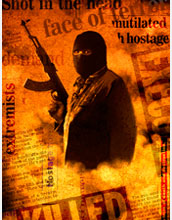Terrorist Groups
The organizational structure of a group determines its strengths and weaknesses. A general knowledge of the prevalent models of terrorist organizations leads to a better understanding of their capabilities. Knowledge of the different labels and systems of classification that have been applied to groups and individuals aid us in discarding useless or irrelevant terms, and in understanding the purposes and usefulness of different terminologies.
In recent times, the popular image of a terrorist group operating according to a specific political agenda and motivated by ideology or the desire for ethnic or national liberation dominated our understanding of terrorism. While still true of some terrorist organizations, this image is no longer universally valid. Also, a generational change in leadership of established groups is in many cases ushering in a more a destructive and relentless type of organization.
Terrorist groups that are associated with a political activity or organization will often require a more hierarchical structure, in order to coordinate terrorist violence with political action. It also can be necessary for a politically affiliated group to observe "cease-fires" or avoid particular targets in support of political objectives. This can be difficult to enforce in networked organizations.

The smallest elements of terrorist organizations are the cells that serve as building blocks for the terrorist organization. One of the primary reasons for a cellular or compartmentalized structure is security. The compromise or loss of one cell should not compromise the identity, location, or actions of other cells. A cellular organizational structure makes it difficult for an adversary to penetrate the entire organization. Personnel within one cell are often unaware of the existence of other cells and, therefore, cannot divulge sensitive information to infiltrators.
Terrorists may organize cells based on family or employment relationships, on a geographic basis, or by specific functions such as direct action and intelligence. The terrorist group may also form multifunctional cells. The terrorist group uses the cells to control its members. Cell members remain in close contact with each other to provide emotional support and to prevent desertion or breach of security procedures. The cell leader is normally the only person who communicates and coordinates with higher levels and other cells.
A terrorist group may form only one cell or may form many cells that operate locally or internationally. The number of cells and their composition depend on the size of the terrorist group. A terrorist group operating within one country frequently has fewer cells and specialized teams than does an international terrorist group that may operate in several countries.
• Categories of Terrorist Groups
Citizens of Ireland and History of the IRA:
History of the Irish Republican Army (IRA)
Ireland Citizenship by Descent Eligibility
Support for the IRA Among Irish Citizen